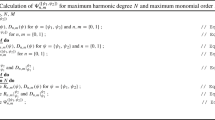Abstract
High resolution transformations between regular geophysical data and harmonic model coefficients can be most efficiently computed by Fast Fourier Transform (FFT). However, a prerequisite is that the data grids are given in the appropriate geometrical domain. For example, if the data are situated on the ellipsoid at equi-angular reduced latitudes, spherical harmonic analysis can be employed and the coefficients subsequently converted by Jekeli’s transformation. This results in the spherical harmonic spectrum in the domain of geocentric latitudes. However, the data are most likely given at geodetic (ellipsoidal) latitudes which means that the FFT base needs to be shifted by latitude dependent phase lags in order to obtain the correct spherical harmonic spectrum. This requires appropriate sample rate conversion about the shifted latitudes by means of Fourier summation and cannot be treated efficiently by an FFT algorithm. In this article another solution is discussed instead. Since the variable heights between the spherical and ellipsoidal surfaces can be accurately approximated by a series of Tschebyshev polynomials, they can be convolved into the spherical basis. It will be shown how this new type of transformation to and from the ellipsoid in combination with Jekeli’s conversion of the spectra between the two surfaces allows eventually the sample rate conversion to shifted latitudes. This avoids the inexpedient Fourier summation mentioned previously. In this paper three applications for FFT in the domain of spherical and ellipsoidal surfaces, and using geocentric, reduced and geodetic latitudes are discussed. The Earth gravitational model EGM2008 of 5 arcminutes resolution has been used to demonstrate numerical results and computational advantages.
Similar content being viewed by others
Explore related subjects
Discover the latest articles and news from researchers in related subjects, suggested using machine learning.References
Abrykosov O. and Förste Ch., 2012. Computation of spherical harmonic coefficients from rigorous integration of gridded terrestrial data. Geophys. Res. Abs., 14, EGU2012–4874.
Beylkin G., 1998. On Application of Unequally Spaced Fast Fourier Transforms. http://amath.colorado.edu/faculty/beylkin/papers/applusfft.pdf.
Colombo O.L., 1981. Numerical Methods for Harmonic Analysis on the Sphere. Technical Report 310. Ohio State University, Columbus, OH.
Dutt A. and Rokhlin V, 1993. Fast fourier transform of nonequispaced data. SIAM J. Sci. Stat. Comp., 14, 1368–1393.
Fukushima T., 2012. Numerical computation of spherical harmonics of arbitrary degree and order by extending exponent of floating point numbers. J. Geodesy, 86, 249–260.
Gleason D.M., 1988. Comparing ellipsoidal corrections to the transformation between the geopotentials spherical and ellipsoidal spectrums. Manuscripta Geodaetica, 13, 114–129.
Gruber Ch., Novák P., Barthelmes F. and Flechtner F., 2014. Derivation of topographic potential from global dem models. In: Rizos C. and Willis P. (Eds), Earth on the Edge: Science for a Sustainable Planet. International Association of Geodesy Symposia 139. Springer-Verlag, Berlin, Heidelberg, Germany, 155–161, DOI: 10.1007/978-3-642-37222-371.
Gruber Ch., Novák P. and Sebera J., 2011. FFT-based high performance spherical harmonic transformation. Stud. Geophys. Geod., 55, 489–500.
Gruber Ch., 2011. A Study on the Fourier Composition of the Associated Legendre Functions; Suitable for Applications in Ultra-High Resolution. Scientific Technical Report 11/04, German Research Centre for Geosciences (GFZ) Potsdam, Germany, DOI: 10.2312/GFZ.b103-11041.
Heiskanen W.H. and Moritz H., 1967. Physical Geodesy. Freeman & Co. San Francisco, CA.
Hobson W.E., 1955. The Theory of Spherical and Ellipsoidal Harmonics. Chelsea Publishing Company, New York.
Hofsommer D.J. and Potters M.L., 1960. Table of Fourier Coefficients of Associated Legendre Functions. Report R 478. KNAW, Computational Department of the Mathematical Centre, Amsterdam, The Netherlands.
Holmes S.A. and Featherstone W.E., 2002. A unified approach to the Clenshaw summation and the recursive computation of very high degree and order normalised associated Legendre functions. J. Geodesy, 76, 279–299.
Hwang C. and Kao Y.C., 2006. Spherical harmonic analysis and synthesis using FFT: Application to temporal gravity variation. Comput. Geosci., 32, 442–451.
Jekeli C., 1988. The exact transformation between ellipsoidal and spherical expansions. Manuscripta Geodaetica, 13, 106–113.
Mohlenkamp M.J., 2000. A Fast Transform for Spherical Harmonics. http://www.ohio.edu/people/mohlenka/research/libftsh/.
Seljebotn D.S., 2012. Wavemoth — fast spherical harmonic transforms by butterfly matrix compression. Astrophys. J. Suppl. Ser., 199, DOI: 10.1088/0067-0049/199/1/5.
Sneeuw N. and Bun R., 1996. Global spherical harmonic computation by two-dimensional fourier methods. J. Geodesy, 70, 224–232.
Author information
Authors and Affiliations
Corresponding author
Rights and permissions
About this article
Cite this article
Gruber, C., Abrykosov, O. High resolution spherical and ellipsoidal harmonic expansions by Fast Fourier Transform. Stud Geophys Geod 58, 595–608 (2014). https://doi.org/10.1007/s11200-013-0578-3
Received:
Revised:
Accepted:
Published:
Issue Date:
DOI: https://doi.org/10.1007/s11200-013-0578-3




